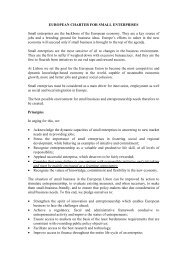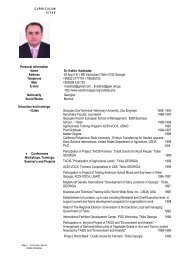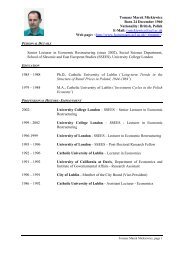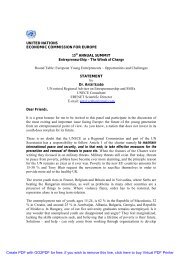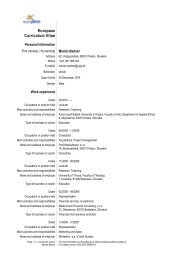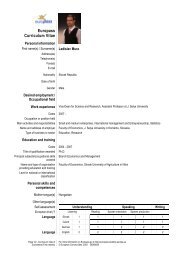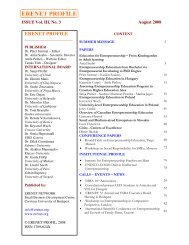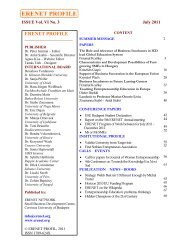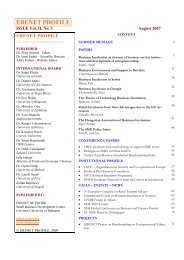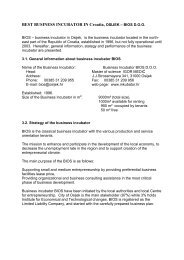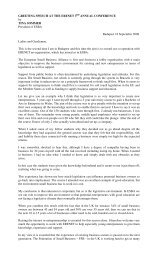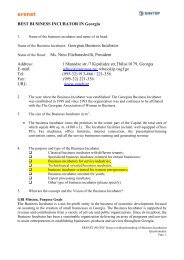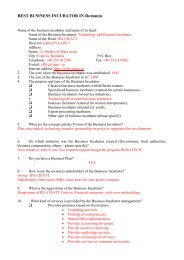Strategies of the Development of Entrepreneurship and SME
Strategies of the Development of Entrepreneurship and SME
Strategies of the Development of Entrepreneurship and SME
Create successful ePaper yourself
Turn your PDF publications into a flip-book with our unique Google optimized e-Paper software.
economy. The so called in <strong>the</strong> organizational sciences “absorptive capacity” or <strong>the</strong> close term“organizational capacity for change” would result in <strong>the</strong> willingness to coop on a country level.With <strong>the</strong> still highly autocratic <strong>and</strong> centralized structure <strong>of</strong> Russian economy Ukraine <strong>and</strong>Moldova have better chances to use <strong>the</strong> globalization factor.PORTER’S DIAMOND MODELFor <strong>the</strong> purposes <strong>of</strong> environmental analysis <strong>and</strong> making recommendations for company’sstrategy consultants usually use several models including Porter’s Diamond approach (Porter,1990), which is enlightening <strong>the</strong> institutional role in <strong>the</strong> company’s success. It gives anopportunity to figure out what is <strong>the</strong> key force/forces in <strong>the</strong> company’s development. There aresome significant limitations to <strong>the</strong> model that we need to describe.The limitations are: 1) <strong>the</strong>model is developed for <strong>the</strong> analysis <strong>of</strong> <strong>the</strong> industry but not an entire <strong>SME</strong> sector analysis; 2)<strong>the</strong> model does not take in account <strong>the</strong> dynamics (history) <strong>of</strong> <strong>the</strong> rivalry, <strong>and</strong> 3) institutionsalso ignored by <strong>the</strong> model (Davis & Ellis, 2001).We would change <strong>the</strong> model, including institutions <strong>and</strong> global dem<strong>and</strong> conditions in it(Figure 1). For <strong>the</strong> current need <strong>of</strong> <strong>the</strong> <strong>SME</strong> sector analysis for three transitioning countries thathave been parts <strong>of</strong> <strong>the</strong> same environment <strong>of</strong> <strong>the</strong> socialist country in a recent past we would notfocus on history <strong>of</strong> rivalry since <strong>the</strong>y had it similar at least for long enough in <strong>the</strong> past. Inaddition to <strong>the</strong> model adjusted to <strong>the</strong> need <strong>of</strong> our analysis some cultural characteristics areresponsible for differences in <strong>the</strong> countries’ situation. We mentioned that already in <strong>the</strong> firstsection while describing socio-cultural characteristics influencing <strong>the</strong> <strong>SME</strong> sector developmentsin each <strong>of</strong> <strong>the</strong> countries.Porter’s model itself represents <strong>the</strong> four factors that are influencing <strong>the</strong> targetedindustry in <strong>the</strong> targeted country. We would be dealing with <strong>SME</strong> sector, not just an industrysince all small businesses in each <strong>of</strong> three countries have comparable characteristics, <strong>and</strong> all <strong>of</strong><strong>the</strong>m are underdeveloped. The company’s competitive advantage is a combination <strong>of</strong> itsresources <strong>and</strong> capabilities.<strong>SME</strong> strategy,structure <strong>and</strong>rivalryCountry factorendowmentsDomesticdem<strong>and</strong>conditionsCountryinstitutionalframeworkGlobal dem<strong>and</strong>conditionsRelated <strong>and</strong>supportingindustriesFigure 1. Adjusted model <strong>of</strong> National Competitive advantage (for <strong>the</strong> Black Sea Region) for<strong>SME</strong> sector analysis70



